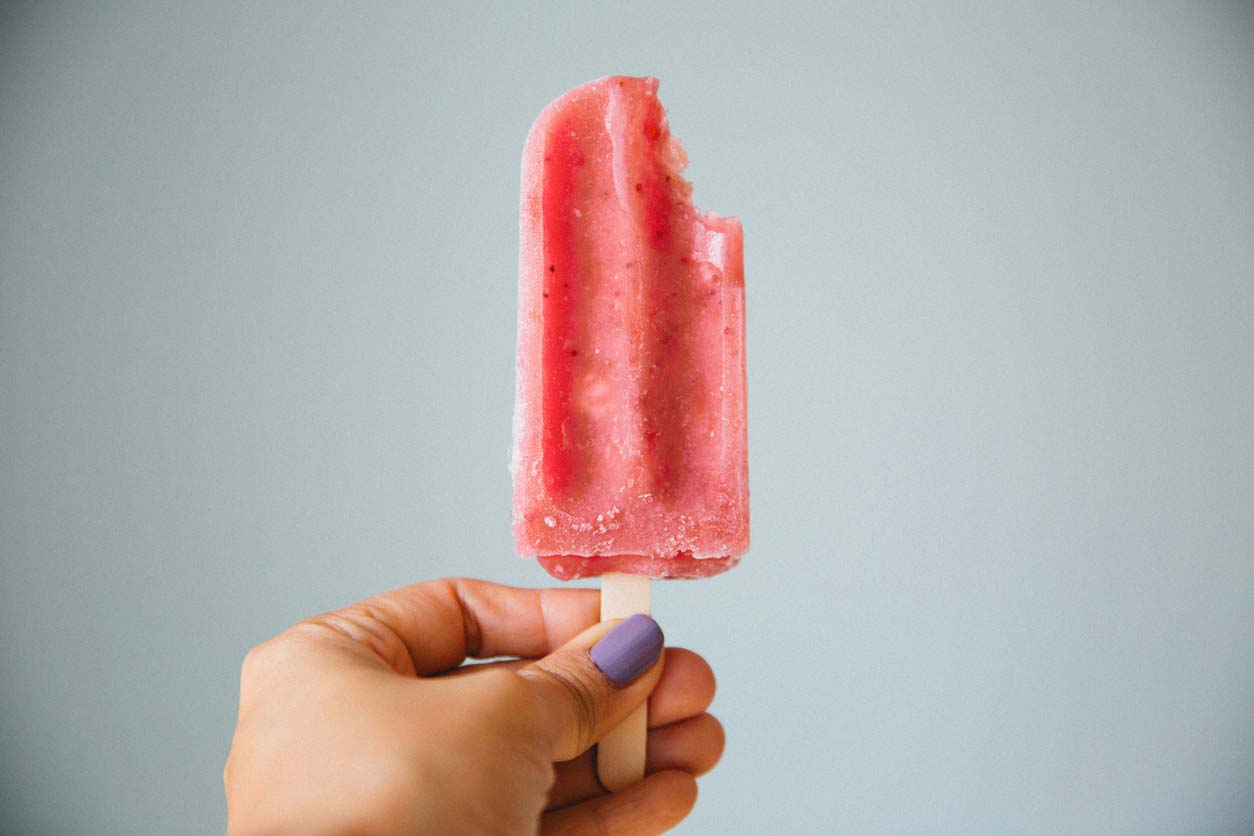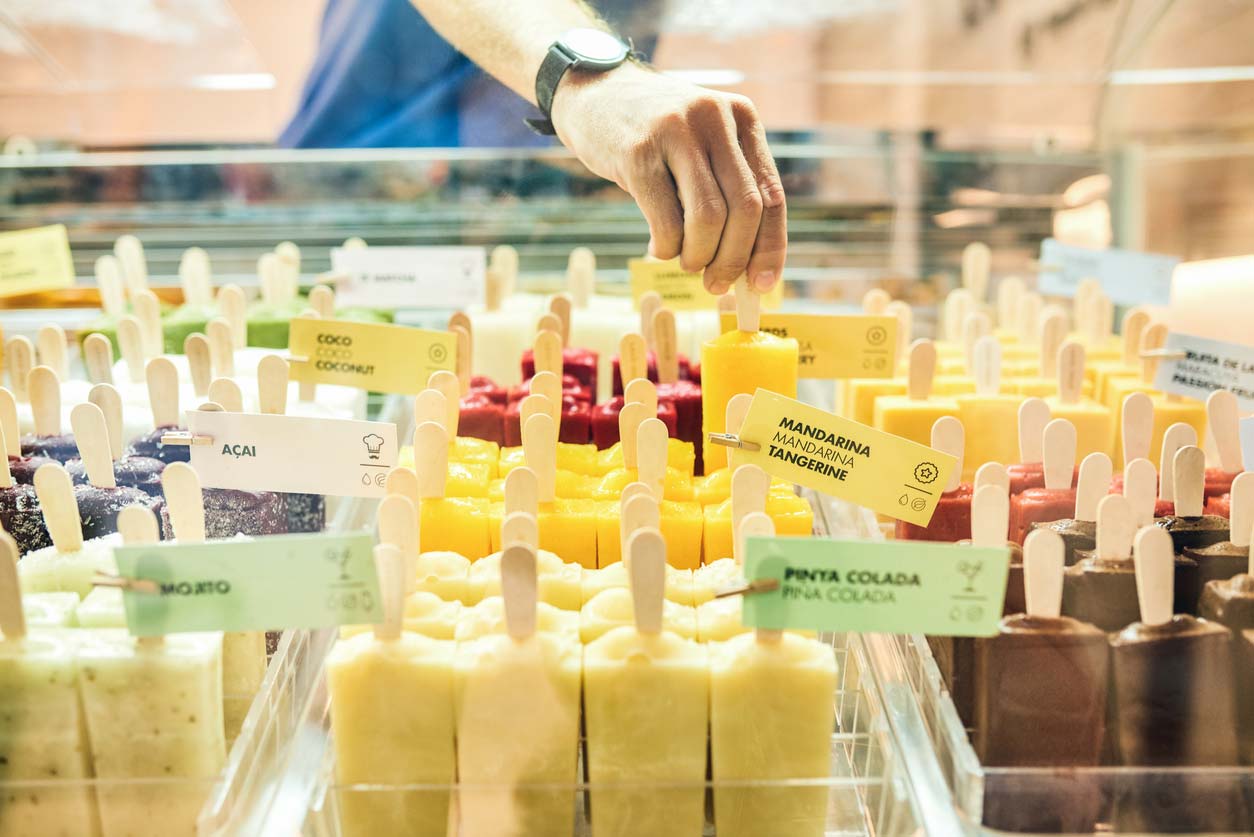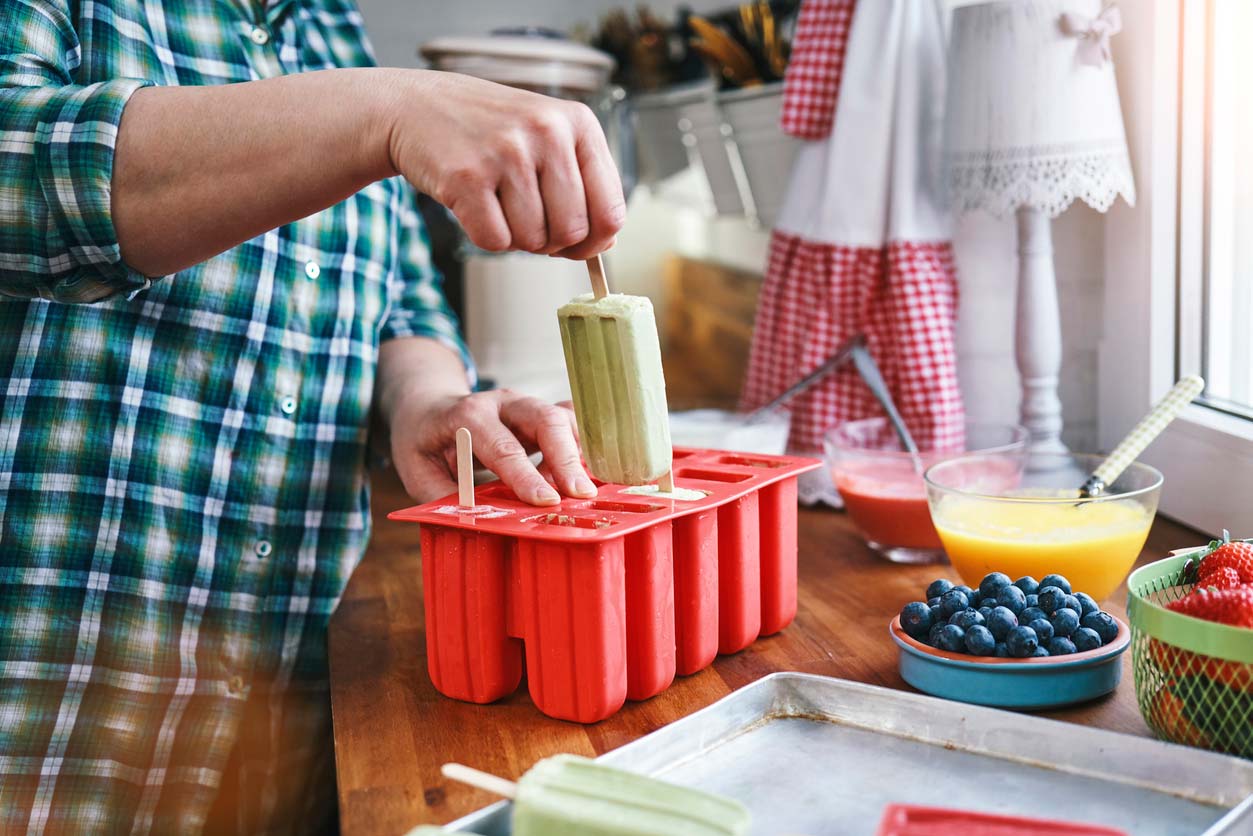There’s a lot of fascinating history around the global trade in frozen water, but let’s
skip to 1905 when a distracted 11-year-old boy named Frank Epperson was playing mad scientist in his front yard. He forgot his mixture of soda powder, sugar, and water outside overnight. The next morning, the wooden stirrer was frozen in place, and Frank had a grand time licking the sweet crystals from what was now the world’s first popsicle.He named it the “Epsicle,” combining his last name with icicle, and started selling them around his neighborhood. Many years later, an adult Epperson patented the treat — now called a “popsicle” — and tried to make a go of it.
His popsicles, marketed as a “drink on a stick,” quickly caught on at San Francisco’s Neptune Beach as a summertime treat — a quick and inexpensive way to cool down on a hot day. They came in different flavors, typically fruit sweetened with sugar.
But without sufficient reach or resources, he went broke, and was forced to sell his invention and brand assets to a larger company, which made it into the ubiquitous dessert we see today. For a while, the Popsicle company and Good Humor were bitter (ironic, huh?) rivals, litigating trademark infringement around the word ‘popsicle.’ Once both brands were acquired by Unilever, the frozen-fruit-juice-on-a-stick world finally experienced peace.
The contemporary popsicle, however, is not exactly a health food. In the ingredients list for the Popsicle brand’s sugar-free Orange/Cherry/Grape assortment, you’ll find maltodextrin (made from GMO corn), glycerin, aspartame, acesulfame potassium, and natural and artificial flavorings.
The good news is, there are many healthy popsicle options you can buy, and many more you can make at home. So what constitutes a healthy popsicle, and what do you need to become your own health-promoting Frank Epperson?
What Is a Popsicle?

The popsicle, sometimes also referred to as an ice pop, is a liquid-based frozen snack on a stick. In the poetic words of Epperson’s patent application, granted in 1924, he had invented a “frozen confection of attractive appearance, which can be conveniently consumed without contamination by contact with the hand and without the need for a plate, spoon, fork, or other implement.”
Initially containing a single stick, the popsicle experienced a seismic moment of evolution when the Popsicle company, in response to the Great Depression, released a two-stick version, meant to be split in half and shared. (If you’ve been eating double-stick popsicles by yourself for decades, don’t feel bad — I didn’t know either until I began my research.)
So essentially, the popsicle is a sweet frozen dessert flavored with sugar, fruit, and artificial ingredients. In addition to traditional fruit popsicles, you can also find milk- and yogurt-based popsicles, and those flavored with chocolate. These dairy popsicles differ from ice cream in that they aren’t whipped and fluffy, but rather just frozen into a solid block. (Less of a drippy mess than an ice cream cone, as long as you avoid Union Square on the summer solstice.)
Ingredients to Look Out for in Popsicles

Sugar
Traditional popsicles are high in sugar, which is pretty harmful to human health when consumed regularly in popsicle-sized servings. According to brain scientists, it lights up the same regions that get turned on by cocaine and other seriously addictive substances. And in doing so, it actually rewires our brains in significant ways.
Artificial Sweeteners
To cater to those who avoid sugar, popsicle manufacturers have introduced sugar-free versions that use artificial or alternative sweeteners. These aren’t much better, if at all. In fact, they can still contribute to health problems like obesity.
Aspartame, a zero-calorie sweetener that’s 200 times sweeter than sugar, appeared to be a wonderful replacement when it was first introduced. Marketed under the brand names NutraSweet and Equal, it was invented in 1965 when a chemist working on an anti-ulcer drug licked his fingers and found them incredibly sweet.
While the mainstream scientific consensus is that aspartame is safe for human consumption, a number of studies suggest that some people may be at risk of heart arrhythmias and other heart problems from consuming aspartame.
Another artificial sweetener, acesulfame potassium, known in the food industry under the cool name “Ace-K” (which is undoubtedly more palatable than its chemical name, potassium 6-methyl-2,2-dioxo-2H-1,2λ6,3-oxathiazin-4-olate), is also used in popsicles and other sweetened foods. Ace-K can also negatively affect the microbiome of mice, leading to weight gain.
Food Additives
It’s not just the sweeteners in popsicles that you may want to watch out for. Many contain maltodextrin, a powdery starch typically made from (GMO) corn, rice, potatoes, or wheat. Maltodextrin, an additive that improves mouthfeel, is one of those “Generally Recognized As Safe” ingredients by the US Food and Drug Administration. But an awful lot of studies cast doubt on that reassurance.
For one thing, maltodextrin can raise blood sugar even faster and higher than regular sugar, a process that, repeated often and long enough, can contribute to the development of type 2 diabetes. Some studies show that the starch can mess with your microbiome, leading to the proliferation of harmful bacteria at the expense of the “good guys” in your gut. This may lead to intestinal disease and inflammatory bowel disorders.
Natural and Artificial Flavors
The ingredient lists for many commercial popsicles also include “natural and artificial flavors.” (We’ve got a whole article on natural flavors, if you’re interested.) The punchline is, the phrase “natural flavors” can disguise any number of substances you probably don’t want anywhere near your mouth. And artificial flavorings — well, why would you want to approximate the taste of a cherry, grape, or orange with the contents of a test tube, rather than just enjoying the real thing?
Food Colorings
Since popsicles are a visual treat as well as a taste sensation, the industry wants the colors to be vibrant and appealing as well. While there are natural colorants (turmeric and annatto extract, for example), the brightest hues come from a lab rather than a plant.
I won’t bore you with a list of all the negative health effects of artificial food coloring right now. Suffice to say that 91 such chemicals were once approved by the FDA and later banned. And many of the approved ones are still suspected of causing cancer and other nasty outcomes.
Dairy
Dairy products represent another category of concern for many popsicle types. Creamsicles, for example, lead off with milk, and also contain cream and whey. For more on the problems with dairy — health-related, ethical, and environmental effects — check out this article.
Healthier Popsicle Brands

While the popsicle’s success spawned many competitors, most also copied the formula for cheap, sugary, chemical-laden treats. Some companies have carved out a healthier popsicle niche, including the following:
GoodPop uses fruit juices, rather than sugar, for the sweetness in their healthy popsicles. They also use fruit juices as colorants, and guar gum for mouthfeel. Their products are USDA-certified organic as well. Check out their Sweet Cherry pop as an example of their line.
You can find them in some natural grocery stores. And you can also order them online.
As a bonus, GoodPop is a certified B-corporation, which means they include social and environmental considerations as part of their bottom line.
Coconut Bliss offers chocolate-y, creamy treats made without dairy. Their Dark Chocolate Ice Cream Bars have just five ingredients: coconut, guar gum, coconut syrup, cocoa, and vanilla extract. They’re also certified organic and gluten-free. You can get two other bar flavors as well: Coconut Almond Crunch and Sea Salt Caramel Swirl. Use their store finder for where to buy near you.
Ruby’s Rockets have a creamy popsicle line made with coconut milk, sweetened with fruit juice concentrates, and flavored with fruit and vegetable purees. A good example is their Tropical Fruit and Veggie Better Bars. They also have a line of fruit juice bars that are like classic fruit-based popsicles. Their store locator will help you find a local source.
The Kroger supermarket chain also offers a store brand, Simple Truth, that caters to health-conscious customers. They sell organic strawberry, Caribbean, and mango pops, in which the main questionable ingredient appears to be added organic cane sugar.
How to Make Your Own Healthy Popsicles

The thing is, once you look at the ingredients in healthy popsicle brands, you may just realize that you can make your own and take complete control over the quality and flavor of your popsicles. And when you look at the cost per unit of these healthier popsicle brands, you’ll realize that you can save a lot of money by making them at home, especially if they’re going to be more than a very occasional treat.
Basically, the instructions for these homemade pops comes down to three steps:
- Blend all the ingredients
- Pour them into a mold
- Freeze
What can you put in your DIY healthy popsicles? Pretty much anything you like! Sometimes simple is best, and a frozen pop made of nothing but fruit juice can be delightful.
You can also add herbs, like mint or basil, depending on the fruit you’re using and the flavor profile you’re going for. While you’re on a green kick, why not toss in some mild veggies, like cucumbers and carrots?
If you prefer the creamy versions, you can blend in a plant-based milk or yogurt. If you’re a fan of chocolate, there are many low-sugar, organic, and ethical brands of dark chocolate that you can use.
And if you’re a beverage sort of person, why not use tea or coffee as a healthy base with a bonus caffeine kick (or not, in the case of herbal or decaffeinated teas).
Popsicle-Making Supplies
You don’t need a lot of equipment to make healthy popsicles, although, of course, you can get as fancy as you like. (There’s probably a line of dedicated gadgets for just about anything you can imagine doing in a kitchen.) Basically, you’ll just need a blender, and it doesn’t have to be a powerful one.
Next, you’ll need popsicle molds and sticks. My two favorite materials for the molds are silicone and stainless steel. This silicone mold makes 10 pops at a time and includes 100 sticks. If you prefer stainless steel, this set makes six popsicles at a time, and comes with 50 reusable bamboo sticks. If you need more sticks, you can find food-grade popsicle sticks online for about $5 for a couple hundred. Make sure, however, that the ones you get are food-grade, and not just intended for arts and crafts.
Finally, you’ll need not only a freezer, but one with enough space to set the molds on a level surface where they won’t be disturbed for the hours it will take for the popsicles to set. It’s no fun to reach for a bag of frozen peas and accidentally create a miniature reenactment of the Snapple Popsicle Debacle in your own kitchen.






Комментариев нет:
Отправить комментарий